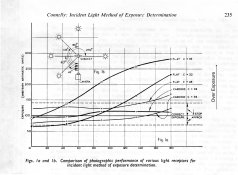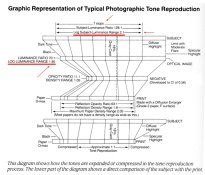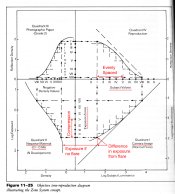Stephen Benskin
Member
Ive been reviewing some old papers and Ive run across something interesting. While the concept is one that is very familiar, it is expressed well. It comes from a paper by Allen Stimson, Measuring and Judging Photographic Exposure of Color Film for Automatic Exposure Controlled Cameras.
Correct exposure can be judged from the appearance of a color transparency, although it may be evaluated differently by different people. Each observer thinks the correct exposure is that which he prefers. If different exposures of the same scene are judged by several observers, the one preferred by the majority is called the preferred picture exposure. The exposure that will be preferred cannot be exactly predetermined, and different observers may not agree closer than +- 1 Ev.
On the other hand, exposure within +-0.5 Ev of the preferred picture exposure can usually be predetermined by photometric measurements of a scene quite satisfactorily for most amateur work. An experienced photographer can often improve the indicated exposure by judging the brightness of the subject in comparison with the general scene conditions measured by the meter, although for many types of scenes, he cannot know in advance the lightness or darkness of the subject matter which will best express the desired mood. Consequently, in important situations, he will make three exposures to bracket the range indicated by the meter.
It is necessary to recognize this fundamental difference between photometric measurement of exposure and preferred picture judgment of exposure. One is foresight while the other is hindsight; the former can be precisely measured and expressed in numbers, while the latter can be found only by judging finished pictures. The two are equal for the statistical average scene.
And from later in the paper:
It has been found that, in judging a sequence of identical pictures having different exposures, observers may differ in their exposure preference for some types of scenes by as much as +-1 Ev. They usually disagree on scenes of lower contrast.
A film may be judged to be overexposed when the sky area loses its color or when flesh tones appear to be washed out. It may be said to be underexposed when the area of greatest interest to the observer is darker than preferred. These criteria are often related to the photometry of the scene only through statistics.
And this is with the small tolerances of color reversal film. Think what the range of preferred picture exposure is with black and white negative film means. Then consider the practicality of the concept of correct exposure, or maybe consider what having a difference between a photometric correct exposure and a preferred picture exposure. Finally, what does this say about an individuals anecdotal observations about the effectiveness of their personal exposure methodology? Perhaps for their conclusions to have any real validity, they should be evaluated from both the photometric exposure and preferred picture exposure perspectives.
Correct exposure can be judged from the appearance of a color transparency, although it may be evaluated differently by different people. Each observer thinks the correct exposure is that which he prefers. If different exposures of the same scene are judged by several observers, the one preferred by the majority is called the preferred picture exposure. The exposure that will be preferred cannot be exactly predetermined, and different observers may not agree closer than +- 1 Ev.
On the other hand, exposure within +-0.5 Ev of the preferred picture exposure can usually be predetermined by photometric measurements of a scene quite satisfactorily for most amateur work. An experienced photographer can often improve the indicated exposure by judging the brightness of the subject in comparison with the general scene conditions measured by the meter, although for many types of scenes, he cannot know in advance the lightness or darkness of the subject matter which will best express the desired mood. Consequently, in important situations, he will make three exposures to bracket the range indicated by the meter.
It is necessary to recognize this fundamental difference between photometric measurement of exposure and preferred picture judgment of exposure. One is foresight while the other is hindsight; the former can be precisely measured and expressed in numbers, while the latter can be found only by judging finished pictures. The two are equal for the statistical average scene.
And from later in the paper:
It has been found that, in judging a sequence of identical pictures having different exposures, observers may differ in their exposure preference for some types of scenes by as much as +-1 Ev. They usually disagree on scenes of lower contrast.
A film may be judged to be overexposed when the sky area loses its color or when flesh tones appear to be washed out. It may be said to be underexposed when the area of greatest interest to the observer is darker than preferred. These criteria are often related to the photometry of the scene only through statistics.
And this is with the small tolerances of color reversal film. Think what the range of preferred picture exposure is with black and white negative film means. Then consider the practicality of the concept of correct exposure, or maybe consider what having a difference between a photometric correct exposure and a preferred picture exposure. Finally, what does this say about an individuals anecdotal observations about the effectiveness of their personal exposure methodology? Perhaps for their conclusions to have any real validity, they should be evaluated from both the photometric exposure and preferred picture exposure perspectives.
Last edited by a moderator:





